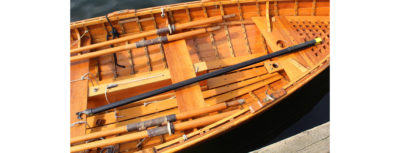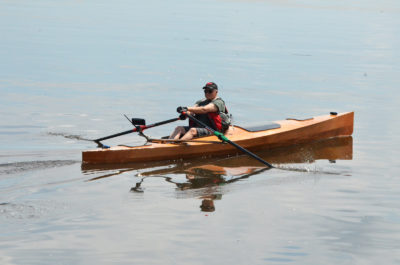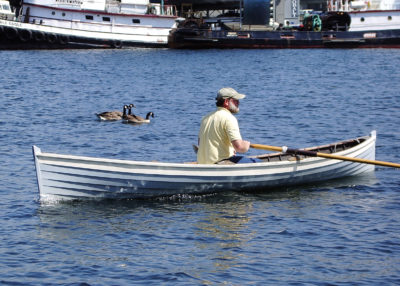While François Vivier's Meaban is a pocket cruiser he designed some 16 years ago, it has the look of a classic from a more distant era. Its design is a development of the Stir-Ven, which is slightly smaller than the Meaban but has a larger cockpit, a small cuddy instead of a cabin, and a transom-mounted outboard instead of an inboard well. In the early 2000s, Vivier began discussions with Pierre-Yves de la Rivière of Grand-Largue, a boatyard in Brittany, about a new design, the Meaban, with a proper cabin, a self-draining cockpit, an outboard well within easy reach, and an option for an inboard engine.“The Meaban’s look was in the spirit of some small yachts as drawn by François Sergent (the Loctudy) or Eugène Cornu (the Bélouga),” said Vivier. “As for all my designs, I wanted to draw a true classic, beautiful and suited to another way of sailing, away from modern marinas. For instance, the low draft makes it an excellent boat for visiting small, drying harbors.” Vivier was particularly keen that the centerboard case shouldn’t encroach too much into the cabin, and so he moved it aft so that it is partly in the cabin and partly in the cockpit. He moved the rig correspondingly aft and gave the hull a plumb stem to maintain balance.He initially designed the boat for strip-planked construction—that was the preference of the person who ordered the first set of plans—but Vivier soon produced new plans for cold-molded construction “which is lighter, easier to build, and completely free of problems due to temperature or moisture content.” Around two dozen boats have now been built, mostly by amateurs, and most are cold-molded. François offers plans and patterns for both a strip-built version of the Meaban and the plywood version shown here. Offsets are not available, so the shapes of the plywood parts are provided as full-sized Mylar patterns or files for CNC-cutting. A 23-page manual is included as a builder’s guide.
Join The Conversation
We welcome your comments about this article. To include a photo with your remarks, click Choose File below the Comment box.













For this and future reviews of trailer boats I’d be interested to know how long does it take to rig the boat from road worthy to sailing shape. Also if the process can be done by a single person or requires some kind of team or mechanical advantage. Some trailer boats take so much labor they only see a trailer at the beginning and end of a sailing season while others are towed to various water bodies and sailed for a weekend or afternoon.
I would bet the gaff rigged version would be easier to set up than the Bermuda. Yes, you have the spar and it’s attendant rigging, but the mast is shorter and easier to handle.
As the builder/owner of RIDEAU I can say that rigging and unrigging at the boat launching ramp takes a little over an hour if I don’t get distracted. Raising the mast is simple and quick using a portable A-frame (2m high) arrangement which sits on the cabin slightly forward of tabernacle and held in place by ropes running forward and back to the berthing cleats. A rope running from the end of the mast, over a roller on top of the A-frame and then attached to the trailer winch raises the mast easily without too much force being placed on the tabernacle. Once the mast is raised the A-frame is stowed in the back of the towing vehicle. On one occasion I lowered and raised the mast at a marina using a double block and the same A-frame arrangement.
I have a Stirven with pretty much the same rig as the Meaban. Fastest I’ve rigged and been sailing is 30 minutes after pulling up to the boat ramp, this was with two of us working like a well-oiled machine. 45min is normal and easily managed by a solo sailor once you have a routine down pat.
I mostly rig and sail solo and don’t use A frames or winches to lift the mast, just stick it in the tabernacle and walk it up, takes about 30 seconds. Pack up always seems quicker than set up about 30 -35 minutes, not including washing boat and trailer after sailing. Hope that helps.
I’m a fan of many of Vivier’s designs. This one reminds me of a slightly compressed version of the San Francisco Bear Boats, designed and built by the Nunes brothers.
Great to see a local build such a beautiful sailboat in my home town of Hobart, Tasmania.
For readers in Australia, as I don’t have the skills to build my own, started searching several years ago and found the Cygnet 20.
Now the proud and happy owner of a Cygnet 20 sailing Victorian waters and soon to head south to my home State.
Any idea of the cost of the kit? Cost of mere plans and off cuts?
I’am just ending the building in France of my own Méaban and the total final cost is in the range of 30 000 Euros.Regarding the kit cost, you can find relevant information in the Pierre-Yves de la Rivière shipyard in France, regarding the plans all the data are on François Vivier website.You may ask him if he has partner in your country able to provide a kit.
I have a blog (in French) on my building.